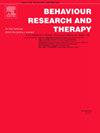Predicting clinical improvement in youth using a national-scale multicomponent digital mental health intervention
IF 4.2
2区 心理学
Q1 PSYCHOLOGY, CLINICAL
引用次数: 0
Abstract
Introduction
Youth mental health services are characterised by high demand and modest clinical outcomes. While digital mental health interventions (DMHIs) have been shown to be clinically effective, the relationship between DMHI use and outcome is unclear. The current study sought to identify the factors affecting the relationship between DMHI use and depression and anxiety symptom improvement in sub-groups of young people.
Method
An observational cohort design included young people aged 12–25 years engaging with a DMHI (MOST) from October 2020 to October 2023. The primary outcome was improvement at 12 weeks on the Patient Health Questionnaire-4 (PHQ4). DMHIs were combinations of self-paced digital cognitive-behavioural therapy content, social network interactions, and professional support. A machine learning clustering algorithm was used to identify distinct user clusters based on baseline characteristics and multiple logistic regression models examined the relationship between DMHI usage and improvement.
Results
Two distinct user clusters emerged, differing by symptom severity, age, service setting, and concurrent external treatment. 46.7% of “Severe” users and 39.8% of “Mild-Moderate” users significantly improved. Greater use of therapy content and professional support interactions were associated with improvement for the Mild-Moderate group only (OR = 1.16, 95% CI: 1.04–1.30, p = 0.008).
Conclusion
While a greater proportion of users in the Severe group significantly improved, increased MOST use was associated with symptom improvement only for the Mild-Moderate group. These findings highlight the complexity of the relationship between DMHI use and outcome. Other unmeasured mediating or moderating factors such concurrent ‘offline’ treatment may help explain the results. Further research is required to better understand the relationship between DMHI use and clinical outcomes.
使用全国范围的多成分数字心理健康干预预测青少年的临床改善
青少年心理健康服务的特点是高需求和适度的临床结果。虽然数字心理健康干预(DMHIs)已被证明在临床上有效,但DMHI使用与结果之间的关系尚不清楚。目前的研究试图确定影响年轻人亚组中DMHI使用与抑郁和焦虑症状改善之间关系的因素。方法观察队列设计纳入了2020年10月至2023年10月参加DMHI (MOST)的12-25岁年轻人。主要结果是患者健康问卷-4 (PHQ4)在12周时的改善。DMHIs是自定进度的数字认知行为治疗内容、社会网络互动和专业支持的组合。使用机器学习聚类算法来识别基于基线特征的不同用户集群,并使用多个逻辑回归模型检查DMHI使用与改进之间的关系。结果在症状严重程度、年龄、服务环境和同时接受外部治疗的情况下,出现了两个明显的用户群。46.7%的“重度”用户和39.8%的“轻度-中度”用户显著改善。仅在轻度-中度组中,更多地使用治疗内容和专业支持互动与改善相关(OR = 1.16, 95% CI: 1.04-1.30, p = 0.008)。结论重度组中有更大比例的患者显著改善,但只有轻度-中度组增加MOST的使用与症状改善相关。这些发现突出了DMHI使用与结果之间关系的复杂性。其他未测量的中介或调节因素,如同时“离线”治疗可能有助于解释结果。需要进一步研究以更好地了解DMHI使用与临床结果之间的关系。
本文章由计算机程序翻译,如有差异,请以英文原文为准。
求助全文
约1分钟内获得全文
求助全文
来源期刊

Behaviour Research and Therapy
PSYCHOLOGY, CLINICAL-
CiteScore
7.50
自引率
7.30%
发文量
148
期刊介绍:
The major focus of Behaviour Research and Therapy is an experimental psychopathology approach to understanding emotional and behavioral disorders and their prevention and treatment, using cognitive, behavioral, and psychophysiological (including neural) methods and models. This includes laboratory-based experimental studies with healthy, at risk and subclinical individuals that inform clinical application as well as studies with clinically severe samples. The following types of submissions are encouraged: theoretical reviews of mechanisms that contribute to psychopathology and that offer new treatment targets; tests of novel, mechanistically focused psychological interventions, especially ones that include theory-driven or experimentally-derived predictors, moderators and mediators; and innovations in dissemination and implementation of evidence-based practices into clinical practice in psychology and associated fields, especially those that target underlying mechanisms or focus on novel approaches to treatment delivery. In addition to traditional psychological disorders, the scope of the journal includes behavioural medicine (e.g., chronic pain). The journal will not consider manuscripts dealing primarily with measurement, psychometric analyses, and personality assessment.
 求助内容:
求助内容: 应助结果提醒方式:
应助结果提醒方式:


